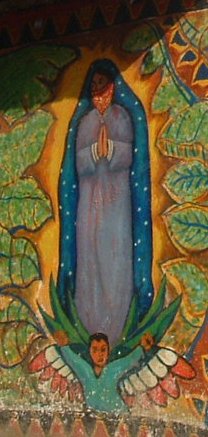
What place might the larger bioregion called Aztlán play in Bioregional Animism for those of us living here? Am I mistaking what I consider my bioregion for what is actually a watershed? Do different disciplines call use these names interchangeably? Either way, I think you know what i mean.
What issues might Aztlán bring up or/and address concerning cultural, ecological, spiritual, political, economic, and other relevant issues?
Mexamerica is a single bioregion, and trying to cut a boregion in half takes a massive amount of energy. Such an expenditure of energy cannot be sustained forever, and when that energy begins to fail, the bioregion will quickly reassert its wholeness.
- http://tobyspeople.com/anthropik/2007/06/nine-nations-mexamerica/
What threatens the invasive culture’s dream most is the fact that a syncretic culture is already developing in the bioregion. Mexican culture had already achieved much of the bioregional syncretic ideal by mixing indigenous and Spanish elements to create a new, creative whole; that it is now so quickly absorbing the invasive culture of Phoenix, Tucson and Los Angeles testifies to the power of the Mexamerican bioregion, and the previous success of the Mexican culture as a syncretic experiment. And what better symbol could there be for the Mexamerican culture than the image of Our Lady of Guadelupe, patron saint of the Americas? . . .
. . . A binational, bilingual, bicultural region is not stable; the real problem agitating so many closeted white supremacists, lurking behind the “border fence” squabbles and the question of “immigration reform” is the understanding that the invasive culture is horrifically unsustainable. Mexican culture has already set a high bar for syncretic, adaptive culture in the Mexamerican bioregion, having incorporated Spain’s invasive culture long ago. Now, it is beginning to incorporate America’s invasive culture. What the gringos are afraid of is precisely the truth: when a sustainable, syncretic culture does eventually emerge, it’s going to have far more in common with the indigenous cultures before the invasion. They still eat the tortillas invented in ancient Teotihuacan. The Virgin of Guadelupe became a superficial mask for Tonantzin. The old gods of Mexamerica are still the Catholic saints venerated by Chicanos today; and it is not a secret continuity. It is understood, and even celebrated. The virulent racism reflects the growing awareness that the invasive gringo culture will simply become the latest palette of colors in which Mexamerica’s natives will paint the same murals they’ve always painted: the murals that express Mexamerica’s genius loci.
- http://tobyspeople.com/anthropik/2007/06/nine-nations-mexamerica/